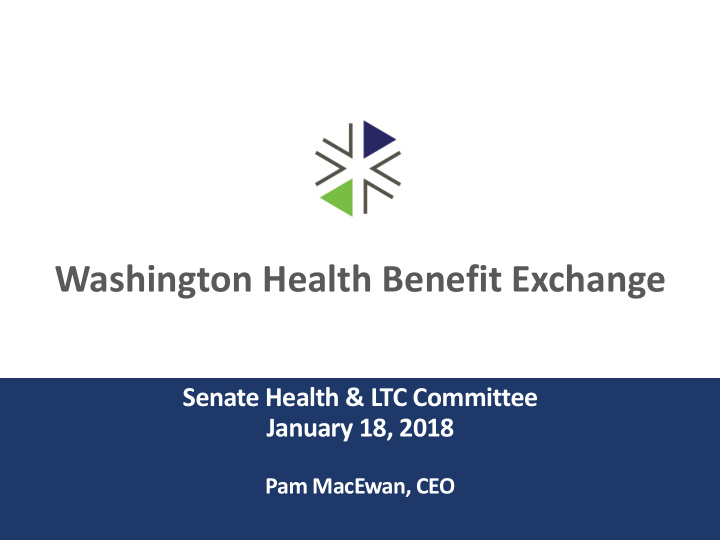



Washington Health Benefit Exchange Senate Health & LTC Committee January 18, 2018 Pam MacEwan, CEO
Key Le Lessons Le Learned From 90s Reform Efforts • Bipartisan support is essential for reform to endure • Subsidized coverage to make coverage affordable • Level playing field for carriers and providers • Individual mandate to sustain risk pool • Limited open-enrollment period to encourage consumers to maintain coverage and provide predictability to carriers 2
Where Do We Go From Here? • What has changed? • Exchange/ Healthplanfinder • Medicaid expansion replaced Basic Health • Defined open enrollment period • Outreach and consumer engagement • Federal subsidies for individual market • Health care costs have continued to sky rocket 3
Where Do We Go From Here? • Reinsurance • Informed, engaged consumers • Sponsorship/Wrap • Streamlined consumer • Cost Containment experience Affordability Accessibility Sustainability Predictability • Coverage • Maintain/grow • Benefits enrollment • Networks • Minimize market segmentation • Quality • Risk pool No Magic Bullets 4
Exchange Contacts • Pam MacEwan, CEO pam.macewan@wahbexchange.org • Joan Altman, Associate Director, Legislative & External Affairs joan.altman@wahbexchange.org 5
Appendix 6
Washington Healthplanfinder https://www.wahealthplanfinder.org/ 7
Fin inancial Assistance • Residents up to 400% FPL may qualify for tax credits that reduce premium costs when coverage is purchased • Residents up to 250% FPL may qualify for cost-sharing subsidies that reduce their out-of-pocket costs when seeking care 100% 138% 250% 400% (Minimum for financial (Medicaid eligibility) (Max income for cost- (Max income for Persons in assistance) sharing reductions) premium tax credits) Household 1 $ 12,060 $ 16,643 $ 30,150 $ 48,240 2 $ 16,240 $ 22,411 $ 40,600 $ 64,960 3 $ 20,420 $ 28,180 $ 51,050 $ 81,680 4 $ 24,600 $ 33,948 $ 61,500 $ 98,400 5 $ 28,780 $ 39,716 $ 71,950 $ 115,120 Source: 2017 FPL Guidelines 8
2018 Pla lan Availability • Fewer insurers: o 7 Exchange issuers (down from 9) o 9 counties have only one insurer offering QHPs ▪ Chelan, Douglas, Ferry, Grays Harbor, Island, Pend Oreille, San Juan, Skagit, Skamania • Offering fewer plans: o 41 QHPs (down from 98) o 7 counties without bronze plans – 2 major carriers do not offer bronze plans ▪ Chelan, Douglas, Ferry, Lincoln, Pend Oreille, Skamania, Stevens • More limited provider networks: No Preferred Provider Organizations (PPOs) 9
2018 QHP Is Issuers by County 7 insurers selling 41 Qualified Health Plans (QHPs) 9 counties with 1 issuer 10
2018 Pla lan Pri ricing • Impact of discontinued federal Cost-Sharing Reduction (CSR) funding: o Eligible silver plan enrollees still receive cost-sharing assistance o To compensate for loss of funds, premiums on silver plans increased an additional 9-27% (depending on the plan) o Silver premium increases resulted in increased tax credits for most subsidized enrollees o Rates for gold, bronze, and catastrophic plans not affected • Higher premiums: o 36% average premium increase (10% due to loss of CSR funds; remainder due primarily to medical and pharmacy cost increases and federal uncertainty) • Higher deductibles: o Median silver QHP deductible will increase from $3,000 in 2017 to $4,500 in 2018 o CSRs still available for silver enrollees under 250% FPL 11
12
Recommend
More recommend